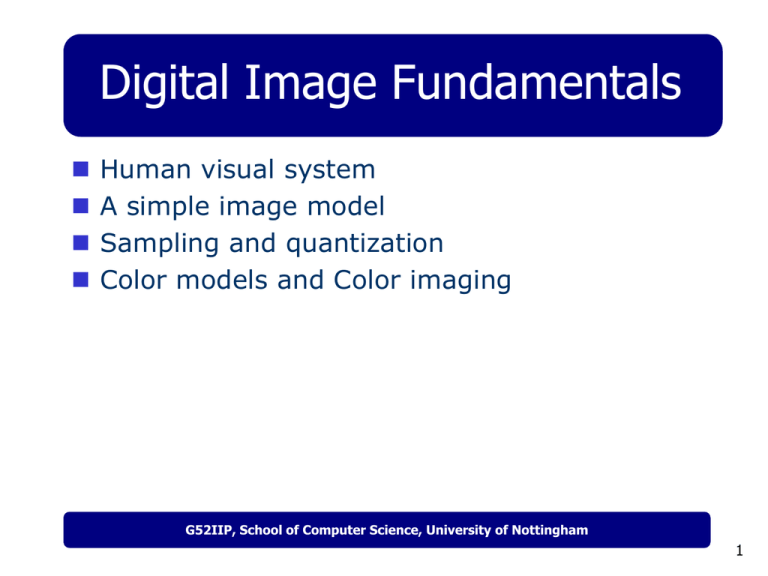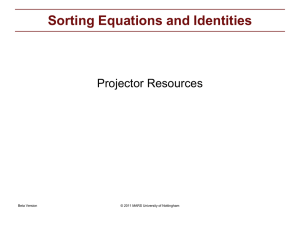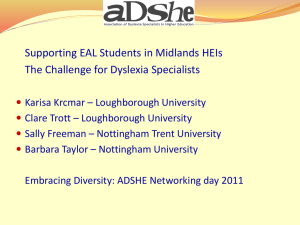ClassSlides - School of Computer Science
advertisement

Digital Image Fundamentals Human visual system A simple image model Sampling and quantization Color models and Color imaging G52IIP, School of Computer Science, University of Nottingham 1 Human Visual System Brightness adaptation Brightness discrimination Weber ratio Mach band pattern Simultaneous contrast G52IIP, School of Computer Science, University of Nottingham 2 Human Visual System Elements of visual perception The amount of light entering the eye is controlled by the pupil, which dilates and contracts accordingly. The cornea and lens, whose shape is adjusted by the ciliary body, focus the light on the retina, where receptors convert it into nerve signals that pass to the brain. G52IIP, School of Computer Science, University of Nottingham 3 Human Visual System Elements of visual perception Cones 6 – 7 million in each eye Photopic or bright-light vision Highly sensitive to color Rods 75 – 150 million Not involved in color vision Sensitive to low level of illumination (scotopic or dim-light vision) An object appears brightly colored in daylight will be seen colorless in moonlight (why) G52IIP, School of Computer Science, University of Nottingham 4 Human Visual System Image formation in the eye Distance between center of lens and retina (focal length) vary between 14-17 mm. Image length h = 17(mm) x (15/100) G52IIP, School of Computer Science, University of Nottingham 5 Human Visual System Human simultaneous luminance vision range (5 orders of magnitude) log (cd/m2) G52IIP, School of Computer Science, University of Nottingham 6 Human Visual System Brightness adaptation HVS can adapt to light intensity range on the order of 1010 Subjective brightness is a logarithmic function of the light intensity incident on the eye G52IIP, School of Computer Science, University of Nottingham 7 Human Visual System Brightness adaptation The lambert (symbol L) is a unit of luminance named for Johann Heinrich Lambert (1728 - 1777), a German mathematician, physicist and astronomer. A related unit of luminance, the foot-lambert, is used in the lighting, cinema and flight simulation industries. The SI unit is the candela per square metre (cd/m²). Source: Wikipedia G52IIP, School of Computer Science, University of Nottingham 8 Human Visual System Brightness adaptation The HVS cannot operate on such range (10 orders of magnitude) simultaneously It accomplishes this through (brightness) adaptation The total intensity level the HVS can discriminate simultaneously is rather small in comparison (about 4 orders of magnitude) G52IIP, School of Computer Science, University of Nottingham 9 Human Visual System Brightness adaptation Sensitivity of the HVS for the given adaptation level Anything below Bb will be perceived as indistinguishable blacks For a given observation condition, the current sensitivity level is call the brightness adaptation level G52IIP, School of Computer Science, University of Nottingham 10 Human Visual System Brightness discrimination Perceivable changes at a given adaptation level G52IIP, School of Computer Science, University of Nottingham 11 Human Visual System Brightness discrimination G52IIP, School of Computer Science, University of Nottingham 12 Human Visual System Perceived brightness is not a simple function of intensity – Mach band pattern G52IIP, School of Computer Science, University of Nottingham 13 Human Visual System Perceived brightness is not a simple function of intensity – Simultaneous contrast G52IIP, School of Computer Science, University of Nottingham 14 A simple image model Two-dimensional light-intensity function f(x,y) = l(x,y) r(x,y) l(x,y) - illumination component r(x,y) – reflectance component G52IIP, School of Computer Science, University of Nottingham 15 A simple image model l(x,y) - illumination range log (cd/m2) r(x,y) – typical reflectance indixes black velvet (0.01) stainless steel (0.65) white paint (0.80) silver plate (0.90) snow (0.93) G52IIP, School of Computer Science, University of Nottingham 16 Sampling Digitization of the spatial coordinates, sample (x, y) at discrete values of (0, 0), (0, 1), …. f(x, y) is 2-D array f (0,0) f (1,0) f ( x, y ) f ( N 1,0) f (0,1) f (1,1) f ( N 1,1) f (0, M 1) f (1, M 1) f ( N 1, M 1) G52IIP, School of Computer Science, University of Nottingham 17 Quantization Digitization of the light intensity function Each f(i,j) is called a pixel The magnitude of f(i,j) is represented digitally with a fixed number of bits - quantization G52IIP, School of Computer Science, University of Nottingham 18 Image Sensor G52IIP, School of Computer Science, University of Nottingham 19 Image Acquisition G52IIP, School of Computer Science, University of Nottingham 20 Image Acquisition G52IIP, School of Computer Science, University of Nottingham 21 Sampling and Quantization G52IIP, School of Computer Science, University of Nottingham 22 Sampling and Quantization How many samples to take? Number of pixels (samples) in the image Nyquist rate How many gray-levels to store? At a pixel position (sample), number of levels of color/intensity to be represented G52IIP, School of Computer Science, University of Nottingham 23 Sampling and Quantization How many samples to take? G52IIP, School of Computer Science, University of Nottingham 24 Sampling and Quantization How many samples to take? The Nyquist Rate Samples must be taken at a rate that is twice the frequency of the highest frequency component to be reconstructed. Under-sampling: sampling at a rate that is too coarse, i.e., is below the Nyquist rate. Aliasing: artefacts that result from under-sampling. G52IIP, School of Computer Science, University of Nottingham 25 Sampling and Quantization How many gray-levels to store? G52IIP, School of Computer Science, University of Nottingham 26 Sampling and Quantization Non-uniform sampling Non-uniform quantization G52IIP, School of Computer Science, University of Nottingham 27 Basic relationships between pixels Neighbors Connectivity G52IIP, School of Computer Science, University of Nottingham 28 Simple intensity processing G52IIP, School of Computer Science, University of Nottingham 29 Color Imaging Light G52IIP, School of Computer Science, University of Nottingham 30 Color Imaging Visible light spectrum G52IIP, School of Computer Science, University of Nottingham 31 Color Imaging Trichromacy and human color vision G52IIP, School of Computer Science, University of Nottingham 32 Color Imaging Color image formation (acquisition) Observer (Camera) RGB Camera Output Light l ( ) Reflected Light l ( ) i( ) Object Reflectanc e i( ) G52IIP, School of Computer Science, University of Nottingham 33 Color Imaging Power spectrum of standard illuminants G52IIP, School of Computer Science, University of Nottingham 34 Color Imaging Color image formation (acquisition) R( x, y ) l ( ) i ( x, y, ) FR d G ( x, y ) l ( ) i ( x, y, ) FG d B( x, y ) l ( ) i ( x, y, ) FB d Color filters Of the sensor G52IIP, School of Computer Science, University of Nottingham 35 Color Imaging Color image formation (acquisition) R ( x, y ) l ( ) i ( x, y, ) FR d G ( x, y ) l ( ) i ( x, y, ) FG d B ( x, y ) l ( ) i ( x, y, ) FB d G52IIP, School of Computer Science, University of Nottingham 36 Color Imaging The RGB Color Model R, G, B at 3 axis ranging in [0 1] each Gray scale along the diagonal If each component is quantized into 256 levels [0:255], the total number of different colors that can be produced is (28)3 = 224 =16,777,216 colors. G52IIP, School of Computer Science, University of Nottingham 37 Color Imaging The RGB Color Model G52IIP, School of Computer Science, University of Nottingham 38 Color Imaging The YIQ Color Model Video (NTSC) standard Y encodes luminance; I and Q encode chrominance (“color”) Black and white TV shows only the Y channel Backward compatibility; efficiency G52IIP, School of Computer Science, University of Nottingham 39 Color Imaging Color Models, YCbCr G52IIP, School of Computer Science, University of Nottingham 40 Color Imaging More Color Models, see e.g., G52IIP, School of Computer Science, University of Nottingham 41 Color Imaging More Color Models, see e.g., G52IIP, School of Computer Science, University of Nottingham 42 Color Imaging Color image representation (in RGB space) = Red Green Blue G52IIP, School of Computer Science, University of Nottingham 43 Color Imaging Color image representation (in RGB space) G52IIP, School of Computer Science, University of Nottingham 44








